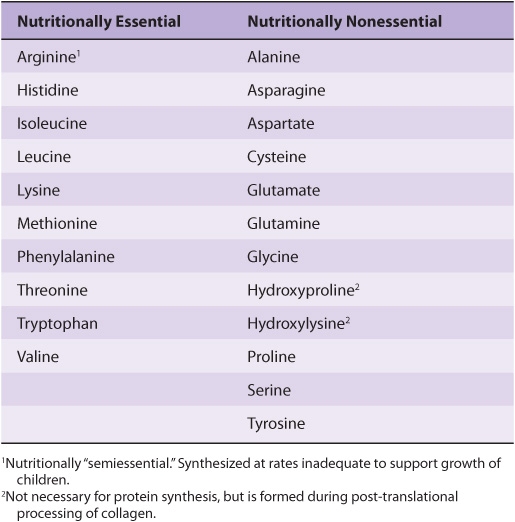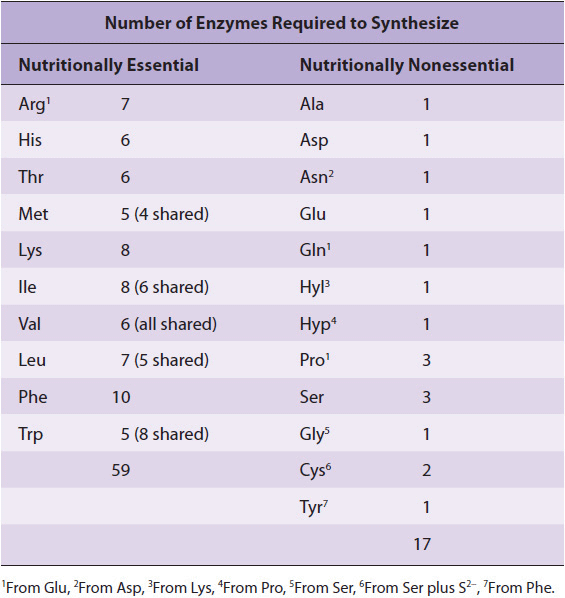27
Biosynthesis of the Nutritionally Nonessential Amino Acids
OBJECTIVES
After studying this chapter, you should be able to:
![]() Explain why the absence from the diet of some amino acids is not deleterious to human health.
Explain why the absence from the diet of some amino acids is not deleterious to human health.
![]() Appreciate the distinction between “essential” and “nutritionally essential” amino acids, and identify the amino acids that are nutritionally nonessential.
Appreciate the distinction between “essential” and “nutritionally essential” amino acids, and identify the amino acids that are nutritionally nonessential.
![]() Name the citric acid cycle and the glycolytic intermediates that are precursors of aspartate, asparagine, glutamate, glutamine, glycine, and serine.
Name the citric acid cycle and the glycolytic intermediates that are precursors of aspartate, asparagine, glutamate, glutamine, glycine, and serine.
![]() Appreciate the key role of transaminases in amino acid metabolism.
Appreciate the key role of transaminases in amino acid metabolism.
![]() Explain the process by which the hydroxyproline and hydroxylysine of proteins are formed.
Explain the process by which the hydroxyproline and hydroxylysine of proteins are formed.
![]() Provide a biochemical explanation for why a severe deprivation of vitamin C (ascorbic acid) results in the nutritional disease scurvy, and describe the clinical consequences of this nutritional disorder.
Provide a biochemical explanation for why a severe deprivation of vitamin C (ascorbic acid) results in the nutritional disease scurvy, and describe the clinical consequences of this nutritional disorder.
![]() Appreciate that, despite the toxicity of selenium, selenocysteine is an essential component of several mammalian proteins.
Appreciate that, despite the toxicity of selenium, selenocysteine is an essential component of several mammalian proteins.
![]() Outline the reaction catalyzed by a mixed-function oxidase.
Outline the reaction catalyzed by a mixed-function oxidase.
![]() Identify the role of tetrahydrobiopterin in tyrosine biosynthesis.
Identify the role of tetrahydrobiopterin in tyrosine biosynthesis.
![]() Indicate the role of a modified tRNA in the cotranslational insertion of selenocysteine into proteins.
Indicate the role of a modified tRNA in the cotranslational insertion of selenocysteine into proteins.
BIOMEDICAL IMPORTANCE
Medical implications of the material in this chapter relate to the amino acid deficiency states that can result if nutritionally essential amino acids are absent from the diet, or are present in inadequate amounts. Amino acid deficiency states endemic in certain regions of West Africa include kwashiorkor, which results when a child is weaned onto a starchy diet poor in protein, and marasmus, in which both caloric intake and specific amino acids are deficient. Patients with short bowel syndrome unable to absorb sufficient quantities of calories and nutrients suffer from significant nutritional and metabolic abnormalities. Both the nutritional disorder scurvy, a dietary deficiency of vitamin C, and specific genetic disorders are associated with an impaired ability of connective tissue to form hydroxyproline and hydroxylysine. The resulting conformational instability of collagen results in bleeding gums, swelling joints, poor wound healing, and ultimately in death. Menkes’ syndrome, characterized by kinky hair and growth retardation, results from a dietary deficiency of copper, which is an essential cofactor for lysyl oxidase, an enzyme that functions in formation of the covalent cross-links that strengthen collagen fibers. Genetic disorders of collagen biosynthesis include several forms of osteogenesis imperfecta, characterized by fragile bones, and Ehlers-Danlos syndrome, a group of connective tissue disorders that result in mobile joints and skin abnormalities due to defects in the genes that encode enzymes including lysyl hydroxylase.
NUTRITIONALLY ESSENTIAL & NUTRITIONALLY NONESSENTIAL AMINO ACIDS
As applied to amino acids, the terms “essential” and “nonessential” are misleading since all 20 common amino acids are essential to ensure health. Of these 20 amino acids, 8 must be present in the human diet, and thus are best termed “nutritionally essential.” The other 12 amino acids are “nutritionally nonessential” since they need not be present in the diet (Table 27-1). The distinction between these two classes of amino acids was established in the 1930s by feeding human subjects purified amino acids in place of protein. Subsequent biochemical investigations revealed the reactions and intermediates involved in the biosynthesis of all 20 amino acids. Amino acid deficiency disorders are endemic in certain regions of West Africa where diets rely heavily on grains that are poor sources of tryptophan and lysine. These nutritional disorders include kwashiorkor, which results when a child is weaned onto a starchy diet poor in protein, and marasmus, in which both caloric intake and specific amino acids are deficient.
TABLE 27–1 Amino Acid Requirements of Humans
Lengthy Metabolic Pathways Form the Nutritionally Essential Amino Acids
The existence of nutritional requirements suggests that dependence on an external supply of a given nutrient can be of greater survival value than the ability to biosynthesize it. Why? If a specific nutrient is present in the food, an organism that can synthesize it will transfer to its progeny genetic information of negative survival value. The survival value is negative rather than nil because ATP and nutrients are required to synthesize “unnecessary” DNA—even if specific encoded genes are no longer expressed. The number of enzymes required by prokaryotic cells to synthesize the nutritionally essential amino acids is large relative to the number of enzymes required to synthesize the nutritionally nonessential amino acids (Table 27-2). This suggests a survival advantage in retaining the ability to manufacture “easy” amino acids while losing the ability to make “difficult” amino acids. The metabolic pathways that form the nutritionally essential amino acids occur in plants and bacteria, but not in humans, and thus are not discussed. This chapter addresses the reactions and intermediates involved in the biosynthesis by human tissues of the 12 nutritionally nonessential amino acids and selected nutritional and metabolic disorders associated with their metabolism.
TABLE 27–2 Enzymes Required for the Synthesis of Amino Acids from Amphibolic Intermediates
BIOSYNTHESIS OF THE NUTRITIONALLY NONESSENTIAL AMINO ACIDS
Glutamate
Stay updated, free articles. Join our Telegram channel

Full access? Get Clinical Tree




